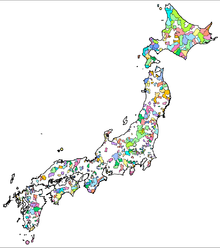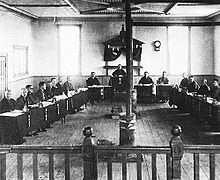Districts of Japan
![]()
Kōri is a redirect to this article. For other meanings, see Kori.
![]()
This article is about the administrative unit in Japan. For the administrative unit in Korea in the Empire of Japan, see Gun (Korea). For the Gun (軍), the armies of the Army in the Empire of Japan, see Regional army.
A county or district (Jap. 郡 gun, historically also kōri; English district or more rarely county) was a local administrative unit in Japan. As such, it had been used since ancient times and from 1878 to 1921 as a level of administration between prefectures and county-level urban (machi) and rural (mura) municipalities after being supplanted, without formal abolition, by feudal hierarchies. In 1942, by decree of the then Ministry of the Interior, it was de facto reactivated for the last time in almost all prefectures (except Hokkaidō) in the form of so-called regional offices (chihō jimusho), and finally abolished in 1947. It is roughly equivalent to the county in the USA or the Landkreis in Germany.

gun in Japan (status: Meiji Restoration)

gun in Japan (as of 2007). The rest are shi and the special districts and sub-prefectures of Tokyo.
Ancient
The counties were originally called kōri and as such had ancient origins in Japan. Although the Nihonshoki claims they were established during the Taika reforms, kōri was originally written as 評. It was not until the Taihō Codex that kōri came into use in the form 郡, which denoted commanders (jùn) in China. Under the Taihō Code, the hierarchy of administrative units was: Province (国, kuni), county kōri, and below that the village (里 or 郷, sato).
Etymologically, the spoken words gun and kuni are related or were adopted into Japanese at different times from different language stages of Chinese - Middle Chinese and Old Chinese. Kōri (pronounced kopori in Old Japanese) is also a loanword, here from Baekje Korean.
Provinces and districts were increasingly irrelevant as administrative units from the Middle Ages onwards, but were used as the primary geographical division of the country - largely static and territorially compact, apart from individual adjustments - in contrast to the political feudal/prefecture division throughout until the late 19th/early 20th century, with the districts also being temporarily revived formally in 1878 as administrative units to subdivide the prefectures.
Modern
During the modernization of the administration in the Meiji period according to Western models, the counties were reorganized in 1878 and 1890 according to the model of Prussian districts (engl. "Bezirk" or "district") and received county administrations appointed by the Ministry of the Interior and indirectly elected county assemblies (gunkai). In order to strengthen the local self-government of the municipalities with their elected institutions, the abolition of the counties was decided in 1921 under the Hara cabinet - the dissolution of the county councils and administrations followed a few years later. Hara, a party politician, had already pushed for abolition in the 1900s: While the county chiefs appointed by the Ministry of the Interior were close to the supporters of the party opponent Yamagata Aritomo, the municipal institutions were a stronghold of the bourgeois parties.
As a geographical and statistical unit, guns have outlived their formal abolition. They are still used today in the Japanese address system to indicate the location of towns and villages. Electoral district divisions for prefectural parliaments also follow county boundaries in many places to this day. At the same time, the composition of counties continues today: If a [historically county] town or village municipality becomes part of or itself becomes an -shi (county-free town), it is no longer included in the county. As a result of the major territorial reforms since World War II, in which the number of -shi almost quadrupled by the early 21st century, many counties have disappeared from the map altogether in this way or have been reduced to individual municipalities.

The Kawabe (Akita) County Council 1923
Search within the encyclopedia